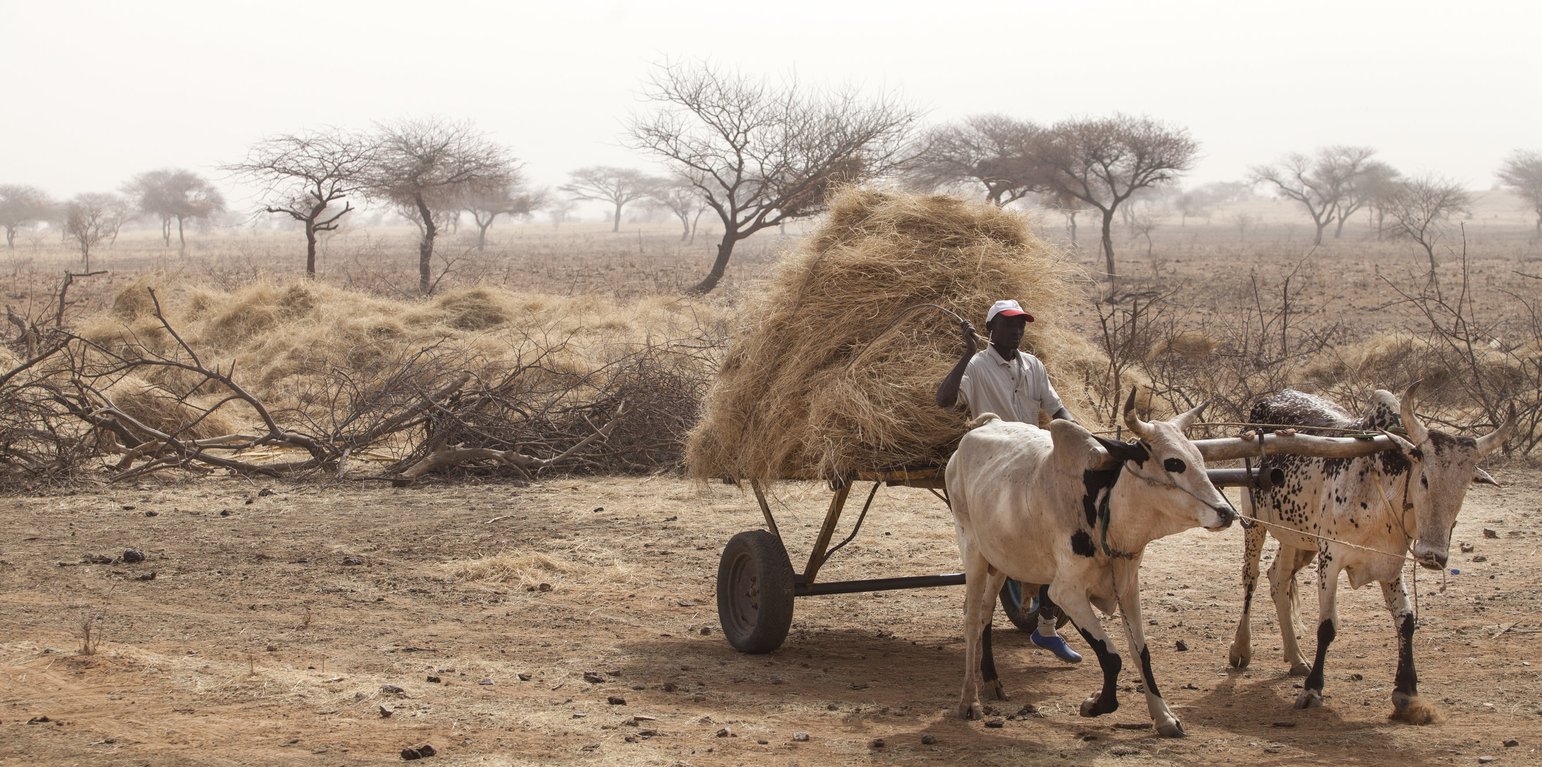Community participation in large-scale land restoration for Africa’s Great Green Wall programme
(Niger)
Description
The Food and Agriculture Organization of the United Nations (FAO) has been using a participatory approach to implement large-scale restoration of degraded land in the Sahel. Communities have been central to the programme. In the framework of the Great Green Wall initiative, adapted and useful native tree species, shrubs, and fodder grasses are planted in agro-sylvo-pastoral land. This is response to community needs and preferences while ensuring that the species and varieties are all ecologically suitable.
The approach is implemented under FAO's Action against Desertification (AAD) programme in the Great Green Wall for the Sahara and the Sahel Initiative (GGWSSI). This is Africa's flagship initiative to combat the effects of climate change and desertification, and to address food insecurity and poverty. It brings together more than 20 African countries with international agencies, research institutes, civil society and grassroots organizations. Through the GGWSSI, the vision is a mosaic of sustainable land use practices and productive landscapes stretching across North Africa, the Sahel and the Horn.
Community participation in the Great Green Wall restoration initiative is through a people-centred approach to rangeland management that puts communities at the heart of efforts. It focusses on plant species that support their livelihoods. Specifically these are a selection of well-adapted indigenous trees, shrubs and fodder grasses with proven resilience to drought and usefulness in restoration. Village communities decide on which areas to plant and on the species that they can utilise for food, for fodder, and for medicines. There are also plants that produce economically valuable goods for local, national and even international markets, such as gum arabic (from Acacia senegal) for example.
Technically, AAD supports the implementation of land restoration activities through provision of equipment, and by strengthening the technical and functional capacities of individuals, communities, and organizations in restoration techniques and sustainable land management.
The three main objectives of this approach are:
a) Poverty alleviation;
b) Ending hunger; and
c) Improving resilience to climate change.
The restoration approach is based on a five-step model:
• Communities: needs and requirements for restoration are determined through in-depth consultations with communities.
• Research: good quality seed is made available for the propagation of economically viable, locally adapted and biodiverse vegetation.
• Operational procedure: efficient operational restoration processes are ensured, including land preparation and management, assisted natural regeneration and planting.
• Monitoring: field performance of species are evaluated, as well as communal activities such as maintenance and management of restored areas.
• Capacity development: village technicians’ capacities are upgraded in forest seed collecting and nursery techniques, planting, maintenance and management of restored areas, and development of plant products, marketing, and local business management.
Location
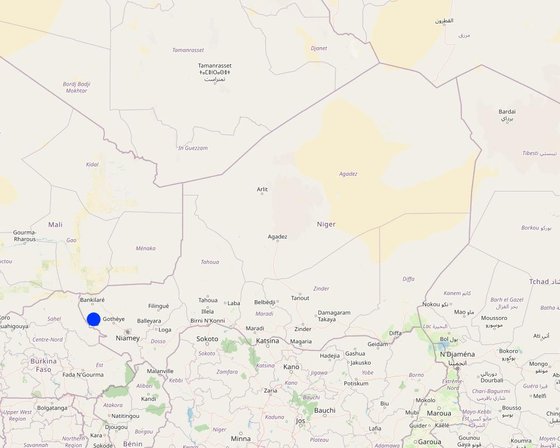
Location: In Niger, the GGWSSI covers all the eight regions of the country. Currently FAO’s Action Against Desertification project works in the three regions of Tillabery, Dosso and Tahoua, though the approach is expanding to the remaining five regions., Tillabery, Dosso and Tahoua, Niger
Geo-reference of selected sites
Initiation date: 2013
Year of termination: n.a.
Type of Approach
-
traditional/ indigenous
-
recent local initiative/ innovative
-
project/ programme based
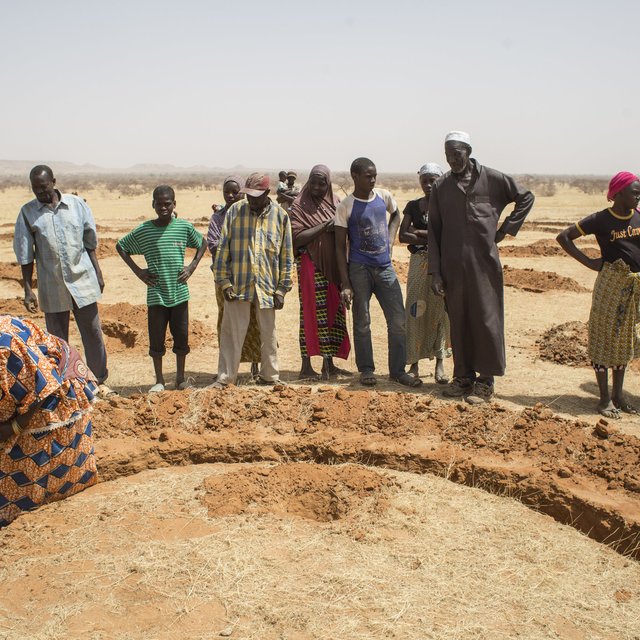
A woman sows a “half-moon” after its construction in Tera, Niger. (©FAO/Giulio Napolitano)
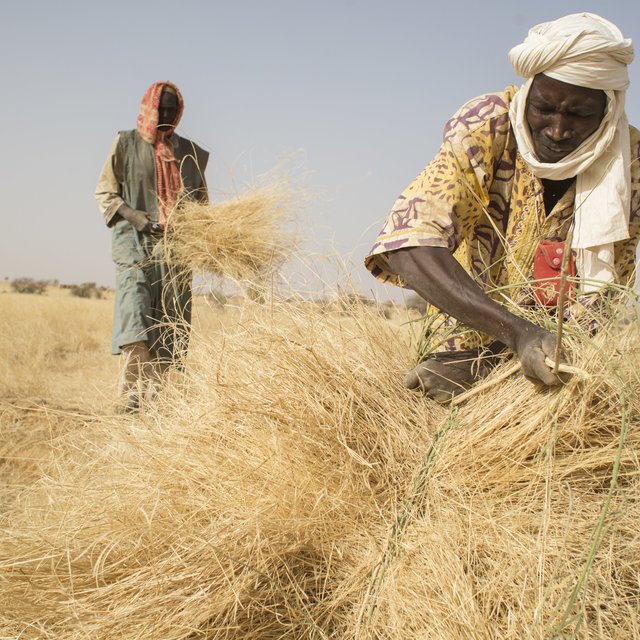
Farmers harvesting hay in Tera, Douma, Niger (©FAO/Giulio Napolitano)
Approach aims and enabling environment
Main aims / objectives of the approach
Key elements and aims of this approach include:
• Planting the right species in the right place.
• Promoting the use of quality native forest and fodder seeds for restoration.
• Ensuring that a wide range of useful plant species is made available.
• Managing natural regeneration of species and planted areas through village management committees.
• Updating a species database for gene-pool traceability, monitoring, reporting and for future uses of data and information.
Conditions enabling the implementation of the Technology/ ies applied under the Approach
-
Social/ cultural/ religious norms and values: The approach is people-centred, and builds on traditional management of land, traditional ecological knowledge and techniques such as “half-moons” (demi-lunes in French) for rainwater harvesting that facilitate improved plant establishment.
-
Availability/ access to financial resources and services: Individuals can acquire finance to buy seeds. On community land, finance may be needed to lease land for production of plant varieties, or for hiring labour to take care of seedlings.
-
Institutional setting: Better organization at local level enhances community participation and commitment to achieve interventions at large-scale/community level.
-
Collaboration/ coordination of actors: There are various levels of collaboration needed for example in establishing which land should/ can be used, in seed selection based on defined needs, and also for the provision of labor. Fundamentally, collaboration is key to agreements to achieve the desired objectives.
-
Legal framework (land tenure, land and water use rights): Securing access rights to land and water resources is a motivation for investing in reforestation.
-
Policies: National level policies can protect and ensure supply of seeds as well facilitate access to natural resources such as land. Additionally, policies such as those in support of Great Green Wall activities create an enabling environment within which these activities can be supported.
-
Land governance (decision-making, implementation and enforcement): Similar to legal framework above.
-
Knowledge about SLM, access to technical support: Knowledge around SLM contributes to maintenance and management of restored areas, thus ensuring sustainability of activities. The programme has integrated existing/traditional SLM activities such as zaï (wide planting pits)/half-moons in capturing, concentrating and storing water thus keeping soils moist and improving the chances of good plant growth in a very dry environment.
-
Markets (to purchase inputs, sell products) and prices: Market access and increasing economic capacities of communities can enable active involvement in restoration especially when plant products can earn income thus facilitating local business.
-
Workload, availability of manpower: Availability of labor facilitates activities such as forest seed collecting, nursery activities, planting, maintenance and management of restored areas. Most of the work is done by women who prepare the land and take the lead in planting.
Conditions hindering the implementation of the Technology/ ies applied under the Approach
Participation and roles of stakeholders involved
Stakeholders involved in the Approach and their roles
| What stakeholders / implementing bodies were involved in the Approach? |
Specify stakeholders |
Describe roles of stakeholders |
| local land users/ local communities |
Total project beneficiaries are currently 116,000 people (over half are women) Age varies from 15 to 70 years. Participants are villagers including farmers, herders, traditional healers and herbalists. Each intervention village has a village management committee set up for GGW implementation. They contribute land and labour, and village technicians are trained in large-scale degraded land restoration techniques so that they can be self-sufficient at the end of the funding. |
1. Defining needs, preferences of species and objectives for land restoration in degraded areas. 2. Trained in the collection of seeds and in how to produce seedlings in village nurseries. 3.The communities involved also participated in the regular monitoring and evaluation of plots. 4. Participating in workshops including agreeing on work plans 5. Communities were also a source of rich traditional ecological knowledge 6. Supporting projects through in-kind contributions of labour and land 7. Representation in the steering committee |
| community-based organizations |
Each intervention village has a village management committee set up for GGWSSI activities. |
- Contributed land, labor and village technicians to be trained in large-scale land restoration techniques geared to self-sufficiency at the end of project life. Managing intervention sites including products such as fodder. Collaborating with national and local administrations. |
| SLM specialists/ agricultural advisers |
Support in identification of land needed for restoration, seeds, and management of restoration. |
|
| researchers |
National seed centres. |
1. Address the availability of good quality seeds for collection.
2. Ensure genetic diversity reflecting varieties of native species. |
| NGO |
Local NGOs and CBOs. |
Local NGO's were trained in land restoration activities.
NGOs were also instrumental in discussions on scaling up the approaches and policy support for mainstreaming sustainable land management. |
| private sector |
Supplies of equipment and materials needed for restoration activities. |
Mainly business related to procurement of goods and services. |
| local government |
Local administration and national governments in the respective countries. |
1. Provide technical management and management of the operational team.
2. Mobilization of communities.
3. Part of the steering committee. |
| national government (planners, decision-makers) |
1. Ministry of Environment and Sustainable Development.
2. National Agency of the Great Green Wall.
3. National Forestry Seed Centre.
4. Local authorities (i.e.Town halls/ Mairies in French) involved in Tillabery, Dosso and Tahoua regions. |
|
| international organization |
Royal Botanical Garden, Kew. |
Technical support; botanical knowledge and information resources, and identifying priority species for the Great Green Wall. |
Involvement of local land users/ local communities in the different phases of the Approach
none
passive
external support
interactive
self-mobilization
initiation/ motivation
Communities’ local knowledge, needs and aspirations were the backbone of the project. Communities were extensively consulted on species identification and prioritization based on needs, including speed of production, personal knowledge and aspirations. This was through questionnaires and village workshops. Commitment and buy-in from the community was also a prerequisite for activities to start, as they had to commit to contribute land and in-kind labour. Selection of villages for restoration was based on, amongst other things, motivation and commitment by communities to participate in restoration activities, and community-based structures and organizations.
planning
Extensive planning was done with communities before implementation, e.g. to agree on planting times, use of traditional techniques and land preparation.
implementation
Implementation was done actively with communities who volunteered traditional knowledge as well as labour to the activities. This built on the initial procedures where species were selected and prioritized; planning of activities; and later labour in preparation of land, setting-up nurseries and transplanting.
monitoring/ evaluation
Monitoring and field data collection of survival and growth of seedlings were carried out by trained village technicians in collaboration with the communities and technical institutions.
Flow chart
Community process.
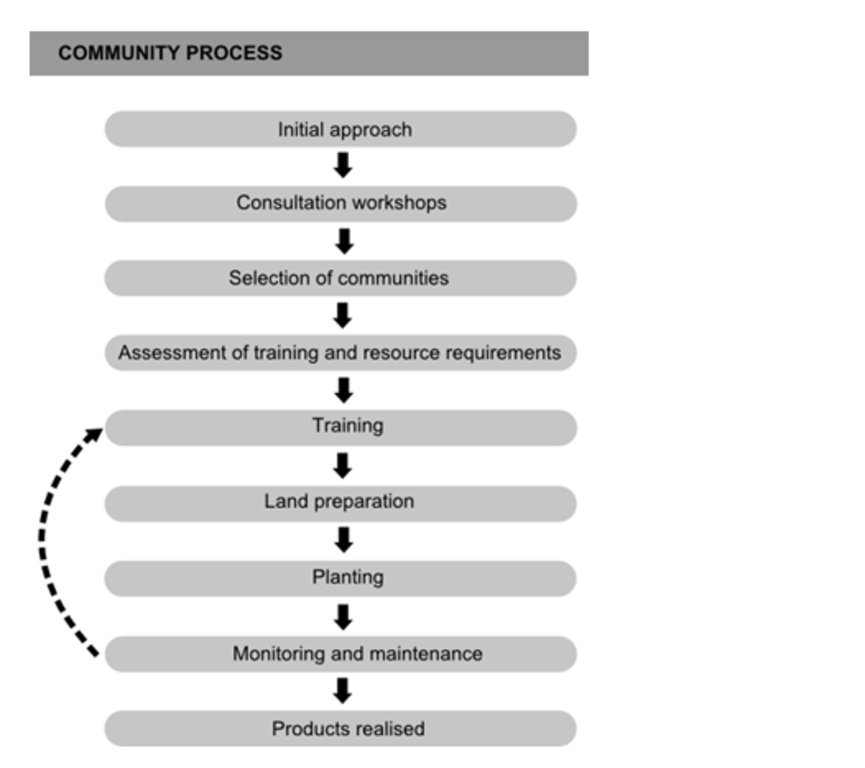
Author: AAD Project
Decision-making on the selection of SLM Technology
Decisions were taken by
-
land users alone (self-initiative)
-
mainly land users, supported by SLM specialists
-
all relevant actors, as part of a participatory approach
-
mainly SLM specialists, following consultation with land users
-
SLM specialists alone
-
politicians/ leaders
Decisions were made based on
-
evaluation of well-documented SLM knowledge (evidence-based decision-making)
-
research findings
-
personal experience and opinions (undocumented)
Technical support, capacity building, and knowledge management
The following activities or services have been part of the approach
-
Capacity building/ training
-
Advisory service
-
Institution strengthening (organizational development)
-
Monitoring and evaluation
-
Research
Capacity building/ training
Training was provided to the following stakeholders
-
land users
-
field staff/ advisers
Form of training
-
on-the-job
-
farmer-to-farmer
-
demonstration areas
-
public meetings
-
courses
Subjects covered
Technical training was provided to villages through formal modules in how to collect quality seeds in defined seed zones. The training was provided by the national forest seed centres. The training was in seedling production and participatory forest management. Other areas covered included; added-value and the development of plant products (non-timber forest products), marketing and local business management to support income generation.
Advisory service
Advisory service was provided
-
on land users' fields
-
at permanent centres
-
workshops
To re-introduce plants for large-scale restoration, effective use of seeds of wild species demands sufficient biological and technical knowledge about a large number of species to allow for collection, storage and germination of seeds and establishment of seedlings. In this approach therefore, use was made of the technical know-how of RBG Kew and their partnership with forest seed centres that guided collection of quality seeds.
Institution strengthening
Institutions have been strengthened / established
-
no
-
yes, a little
-
yes, moderately
-
yes, greatly
Describe institution, roles and responsibilities, members, etc.
Institutions: National government; NGOs, CBOs.
Support to the national government which is the national agency for the GGW is the entry point. Through them and based on national objectives, the project progresses to a decentralized level. At the national level, capacities have been improved on monitoring and evaluation techniques; seed identification and selection and handling.
Local level: these are the implementing partners and work on the ground. Their capacities have been improved on seed selection and restoration techniques, and on data collection
Regional level: more collaboration, coordination and knowledge sharing on the GGW initiatives as well as peer-to-peer learning.
Type of support
-
financial
-
capacity building/ training
-
equipment
Further details
Equipment: mainly for land preparation for planting and non-timber forest product processing.
Monitoring and evaluation
Regular monitoring is carried out by village communities involved in the restoration exercise. The activities include assessing seedling survival and growth, and the area planted.
Research
Research treated the following topics
-
sociology
-
economics / marketing
-
ecology
-
technology
Through a questionnaire, communities define their needs and preferences for species, and the objectives of land restoration in their selected agro-sylvo-pastoral degraded lands. Results of this consultation are fed back to them after analyses by the project team (researchers, plant experts, seed centres) for the feasibility, suitability and availability of the requested species. This creates common agreement on interventions, priorities and implementation plans, with roles and responsibilities from the communities as well as from the technical teams.
1. Sociology: prior research was done on social diversity of village communities in areas such as gender, age, and professions to decide on village selection, but also to ensure balance.
2. Economics/marketing: this was multi-faceted - on the one hand looking at community economic needs and priorities, but also on how to add value to non-timber forest products. The plant-use data received from respondents were classified according to the Economic Botany Data Collection.
These helped in deciding and prioritizing species according to community needs.
3. Ecology: the GGW initiative is typically aimed at drylands with challenges of aridity. Thus the ecology was studied to identify suitable plant species that would thrive under these conditions - in combination with traditional SLM/ water harvesting technologies that have been developed to overcome moisture deficits.
The selected species was further examined in laboratories to check their suitability for dryland environments and thereafter to ensure good quality and genetically diverse seeds are used.
Financing and external material support
Annual budget in USD for the SLM component
-
< 2,000
-
2,000-10,000
-
10,000-100,000
-
100,000-1,000,000
-
> 1,000,000
Precise annual budget: n.a.
Action Against Desertification is implemented by FAO and partners with funding from the European Union in the framework of the 10th European Development Fund (EDF). The GGWI under AAD in Niger is funded up to around 1.5m USD for the four years of the project.
The following services or incentives have been provided to land users
-
Financial/ material support provided to land users
-
Subsidies for specific inputs
-
Credit
-
Other incentives or instruments
Financial/ material support provided to land users
Finances are needed for purchasing equipment; seeds were also provided; seed testing was carried out to establish appropriate type/species of those chosen by the communities.
partly financed
fully financed
labour
Local communities shared some tasks such as during planting period the project provided lunch.
equipment: machinery
Provided such as hand tools, and carts for transportation.
equipment: machinery: tools
Tools for SLM/WH structures and planting.
agricultural: seeds
Training was provided in a collection of native forest seeds that were then bought from them (communities thus earning an income).
construction: stone
For storage facilities.
Labour by land users was
-
voluntary
-
food-for-work
-
paid in cash
-
rewarded with other material support
Other incentives or instruments
Functional capacity building village communities for example in management of restoration sites and development of forest products
Impact analysis and concluding statements
Impacts of the Approach
No
Yes, little
Yes, moderately
Yes, greatly
Did the Approach empower local land users, improve stakeholder participation?
The project supports communities to improve the productivity of their land in direct consultation with them while benefiting from training on recording changes in the diversity of biomass in community plots and lands.
Did the Approach enable evidence-based decision-making?
Did the Approach help land users to implement and maintain SLM Technologies?
Training was provided in various aspects such as seed selection and collection.
Did the Approach improve coordination and cost-effective implementation of SLM?
The project is not funding all aspects, though building sustainability through the direct capacity development and participation of communities.
Did the Approach mobilize/ improve access to financial resources for SLM implementation?
1. Village technicians have been used by other projects in the area in SLM and also by the government while receiving remuneration.
2. Communities are able to sell indigenous seeds for restoration to other projects in the region, and to the government.
Did the Approach improve knowledge and capacities of land users to implement SLM?
Did the Approach improve knowledge and capacities of other stakeholders?
1. Governments; training of technicians in specialized tools, training in monitoring and evaluation of SLM and in restoration impacts.
2. CBOs and local administrations: regional organizations such as CILSS-Agryhmet were also trained in the above.
Did the Approach build/ strengthen institutions, collaboration between stakeholders?
The village technicians and trained seed collectors have now been organized into a regional union for supply of restoration seed.
Did the Approach mitigate conflicts?
With the increasing of fodder production, pressures on other grazing areas have gone slightly down.
Did the Approach improve gender equality and empower women and girls?
Yes; gender equality is taken into consideration – for example, women are represented in each village management community.
Did the Approach encourage young people/ the next generation of land users to engage in SLM?
As income comes in from restoration activities, it has encouraged young people to consider SLM as an income generating opportunity.
Did the Approach improve issues of land tenure/ user rights that hindered implementation of SLM Technologies?
Communities now see more value in restoring degraded land previously neglected and there are tenure agreements with local administration. Land tenure had been insecure for local communities, but now rights of access and use have been delivered by local administrations to local communities, guaranteeing that restoration areas belong to communities - thus ensuring sustainability, as a community perceives ownership of the investments.
Did the Approach lead to improved food security/ improved nutrition?
1. Farming in restored areas allows for more crop production.
2. Fodder production is feeding livestock better improving production of milk and meat.
Did the Approach improve access to markets?
1. Seeds and fodder are being sold by local communities to other projects, governments and communities.
Did the Approach lead to improved access to water and sanitation?
not applicable.
Did the Approach lead to more sustainable use/ sources of energy?
not applicable.
Did the Approach improve the capacity of the land users to adapt to climate changes/ extremes and mitigate climate related disasters?
The project’s aim is to increase the resilience of natural capital and people living in the drylands while being able to adapt to climate change.
Did the Approach lead to employment, income opportunities?
In seed sales, crop production, income earning from employment of technicians.
Main motivation of land users to implement SLM
-
increased production
-
increased profit(ability), improved cost-benefit-ratio
-
reduced land degradation
-
reduced risk of disasters
-
reduced workload
-
payments/ subsidies
-
rules and regulations (fines)/ enforcement
-
prestige, social pressure/ social cohesion
-
affiliation to movement/ project/ group/ networks
-
environmental consciousness
-
customs and beliefs, morals
-
enhanced SLM knowledge and skills
-
aesthetic improvement
-
conflict mitigation
Sustainability of Approach activities
Can the land users sustain what hat been implemented through the Approach (without external support)?
The capacity being developed should help farmers continue without external intervention e.g. training in collecting planting material, planting techniques and in managing the plots enables continuity, and the capacities developed stay within the community – for example: the trained village technicians.
Conclusions and lessons learnt
Strengths: land user's view
-
Builds on existing knowledge such as the use of zaï (pit planting).
-
Income generation e.g. from selling of seeds to governments and other land users.
-
Helping achieve communities specifics objectives such as increasing tree cover.
Strengths: compiler’s or other key resource person’s view
-
The consultation process and the mutual trust built over time, which helps people “buy into” the programme and feel ownership of the activities on the ground.
-
The technical and scientific feedback answers to priorities and preoccupation of land users in terms of restoration objectives.
-
The involvement of people in monitoring and management of their planted sites as they contribute their lands and labour.
Weaknesses/ disadvantages/ risks: land user's viewhow to overcome
-
Inability to adequately influence donor plans.
Frequent consultations.
Weaknesses/ disadvantages/ risks: compiler’s or other key resource person’s viewhow to overcome
-
Inability to address all the needs of the beneficiaries: for example demand for water supply in dry seasons while the project focusses on rainfed restoration.
Increased dialogue on interventions across sectors, such as with donors for a more systematic and integrated approach.
-
Lack of flexibility in implementation to consider some of the upcoming demands of communities.
References
Editors
-
Moctar Sacande
-
Vivian Onyango
Reviewer
-
Donia Mühlematter
-
Simone Verzandvoort
-
Rima Mekdaschi Studer
-
Joana Eichenberger
Date of documentation: July 5, 2017
Last update: Aug. 21, 2024
Resource persons
-
Vivian Onyango (vivian.onyango@fao.org) - SLM specialist
-
Moctar Sacande (moctar.sacande@fao.org) - SLM specialist
Full description in the WOCAT database
Documentation was faciliated by
Institution
- Food and Agriculture Organization of the United Nations (FAO) - Italy
Project
- Book project: Guidelines to Rangeland Management in Sub-Saharan Africa (Rangeland Management)
- FAO-Action Against Desertification
Key references
-
FAO. 2015. Global guidelines for the restoration of degraded forests and landscapes in drylands: building resilience and benefitting livelihoods. Forestry Paper No. 175. Rome, Food and Agriculture Organization of the United Nations.: UN-FAO
-
Community participation at the heart of Africa’s Great Green Wall Restoration model. Authors: M. Sacande, N. Berahmouni and S. Hargreaves. In Unasylva. Volume 66 2015/3: UN-FAO
Links to relevant information which is available online
